The National Oceanic and Atmospheric Administration’s National Environmental Satellite, Data and Information Service, or NESDIS, has released a concept study by Lockheed Martin and NVIDIA on the artificial intelligence-driven Earth Observation Digital Twin, or EODT, technology.
NOAA said Thursday the study, conducted by the two companies under a 2022 Joint Ventures Partnership broad agency announcement contract, highlights how EODT can unify data from oceans, land, atmosphere, cryosphere and space weather to support forecasting and impact assessments.
EODT is a digital replica that simulates real-world systems, environments or objects, constantly updated through satellite inputs, machine learning and other data. These virtual copies deliver actionable insights to federal agencies, researchers and industry.
Recommendations for Future EODT Architecture
The study provided NESDIS with recommendations aimed at building an advanced ground enterprise system. These recommendations emphasize standardization and interoperability to enhance collaboration across government and other EODT initiatives.
The suggestions are as follows:
- Expand digital twin initiatives across NOAA, other federal agencies, academia and industry by aligning data standards.
- Develop a flexible EODT architecture with data archives, a standardized data file formatter, algorithm processing services, and common and tiled processed file formats.
- Enhance NOAA-wide data standards for efficient ingestion.
- Explore the development of a separate digital twin for space weather.
- Develop multiple digital twins at different scales focused on specific aspects of the Earth system.
- Utilize Observing System Simulation Experiments to optimize the integration of processes.





